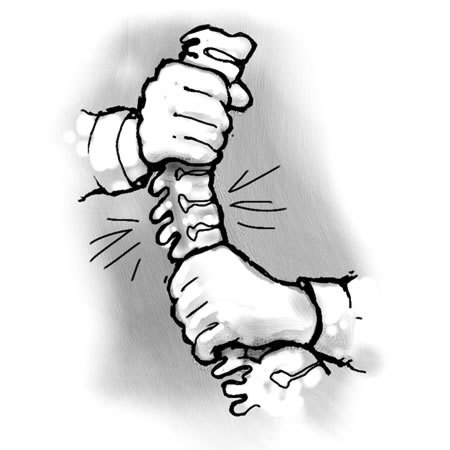Article reviewed and approved by Dr. Ibtissama Boukas, physician specializing in family medicine
I can already see the skeptics frown upon reading the title of the article. You might tell me:
"But yes, the vertebrae can move! And the pelvis can shift!”
Or
“The last time I got my back stuck I went to see my therapist and he put my L4-L5 back! »
This is a myth! No, your vertebrae are not displaced. Nor staggered. Nor stuck. Neither blocked (literally).
But then, you will ask me, why did my chiropractor, osteo or other, tell me that he had to replace my lumbar vertebrae to reduce the pain? And why are the manipulations of my favorite therapist doing me so much good? This is what we will discuss in the next lines.
I got my back stuck!
Ahhhhh, Canadian winter! A time when snowfall can be up to 30 centimeters high! Guess who has to shovel their driveway to get their car out of the house?
Unfortunately, this exercise causes kidney towers in several individuals each year. As a physiotherapist, I can tell you that many people come to see me writhing in pain after clearing snow.
Most often, they have a leaning forward posture, and are unable to straighten up. They regularly tell me that “their vertebrae got stuck”, or that their back is “blocked”. What is it really?
Perceptions are sometimes deceiving!
Pain creates a distortion of body image, a bit like having an altered image of our anatomy. For example, a survey demonstrated that people with unilateral lower back pain thought their trunk was deviated to the painful side – when it was not!
Well, after an acute episode of lumbago, your back may actually be leaning forward. But you should also know that pain creates a protective mechanism, with muscle spasms giving the impression that the lumbar vertebrae are “blocked”, “moved”, “stuck”.
In short, having the feeling that our back is not straight is not necessarily representative of reality. Where then do the many claims that the vertebrae can move come from?
If you fear that your condition is serious, fill out this questionnaire which will allow you to tell if your back pain comes from a serious attack: I have back pain: is it serious?
The subluxation theory
There was a time when the subluxation theory was very common, especially in the field of chiropractic. Basically, many therapists attributed cervical or lumbar pain to mini spinal dislocations.
These stresses would compress the nerve roots and nerves emerging from the spine. This is where the famous phrase comes from. vertebrate moved”!
By the way, this theory was also used to explain other health problems, and a “readjustment” of these vertebrae could supposedly treat medical conditions like headaches, asthma, balance problems or allergies. .
Today we realized that this complex and controversial theory had no no scientific basis. Firstly, the identification of “subluxated” levels is not unanimous. A survey revealed that some chiropractors could not agree on which lumbar vertebrae to readjust in patients with low back pain.
Furthermore, it should be realized that a spine misaligned (literally this time!) is not necessarily synonymous with pain. For example, many people with significant scoliosis diagnosed on x-ray yet have NO lower back pain. The same is true for nerve root damage.
Indeed, many people with nerve compression observed on MRI and caused by a herniated disc yet had no symptoms…no pain, no numbness, no tingling!
Can I benefit from the manipulations of my favorite therapist?
“However, I have less pain when my osteopath crack my back!”
This is what I hear regularly when I mention the myth of the displaced vertebra.
Be careful, this does not mean that spinal manipulations (the fact of “cracking” your vertebrae) are not effective. Moreover, it remains possible to have a joint problem at the level of the lumbar vertebrae which could explain your pain.
These joint dysfunctions can for example be inflammatory (like an overstretched ligament or muscle)… but they are simply not related to displaced or stuck vertebrae in the proper sense.
Unfortunately, many people still think that their body can be likened to a legos overlay able to move at the slightest wrong move. Obviously, this feeling of insecurity will strongly affect the confidence you have in your back!
The (disastrous) consequence of this way of thinking is people who avoid moving for fear of aggravating their condition. Ironically, this is where chronic pain sets in, and creates a terrible vicious cycle.
The most important point to remember is that your body is strong. Your vertebrae cannot move (unless there is a major accident). And cracking your vertebrae doesn't snap them back into place either. On the other hand, it is possible to benefit from it to reduce your pain and increase your mobility. How?
To date, there are some theories explaining the reduction in pain after joint manipulation:
- 1. Most likely comes from a nervous system desensitization. Let me explain. When your therapist performs a manual therapy technique, a message is sent to the central nervous system (ie. your heart).brain). The brain therefore realizes that this region can be mobilized without worsening your condition, and thus reduces the painful message sent to the lumbar level.
- 2. Other theories involve a overstretching of muscles and joint capsules (responsible for the cracking noise due to gas cavitation). This rapid stretching would also have a muscle inhibition effect, which would reduce painful spasms.
- 3. The last theory not to be underestimated is thePlacebo effect. The presence of the therapist, the noise caused by the joint cracking, the feeling that our back is “back in place” (even if it is not true!), all of this creates a favorable environment for the reduction of symptoms.
Safety first
Yes, spinal manipulations are generally safe, especially when performed by a trained therapist. The Side effects are mild to moderate, and cases of fatal complications are extremely rare.
These may include nerve or disc irritation, bone damage (fracture), hematoma or edema, panic attack, or dizziness. Moreover, spinal manipulations are not as dangerous at the lumbar level as at the cervical level.
If you've ever heard catastrophic stories involving dissection of thevertebral artery or death, they were probably the result of cervical manipulation by a possibly unqualified therapist.
Aside from the minimal risk, it's still important to keep in mind that spinal manipulation involves a rapid, forced passive movement that aims to stretch the ligaments and muscles around your vertebrae to the extreme of anatomically possible movement.
For these reasons, certain conditions constitute a contraindication to the manipulations. Thus, no therapist should manipulate you if you have any of the following:
Contraindications to spinal manipulations
- Problem of non-mechanical origin (infectious, tumoral, etc.)
- Suspected fracture, sprain or serious traumatic pathology
- Advanced osteoporosis
- Joint instability
- Hyper-anxious patient
- Severe rheumatoid arthritis (especially for cervical manipulations)
- History of vertebral artery dissection (especially for cervical manipulations)
- If possible, find alternatives to cervical manipulation considering the potential risks
The moral of the story (in the form of highlights)
Here is a summary of the points to remember after reading this article:
- Understand that manipulations do not put your vertebrae back in place. Why? Because they weren't moved in the first place! Your body is strong, never forget that!
- As the manipulations have no specific effects, it is not necessary to isolate the region to be treated. Moreover, an absence of cracking does not mean that your therapist “missed” his shot!
- Safety must be prioritized above all else. Look for a qualified therapist and who you trust.
- It should be understood that passive therapies offer limited effects over time. If possible, do not depend on a therapist to reduce your pain by consulting excessively.
- Make sure you are dealing with the cause of your problem, not the consequences. It's there that exercise comes into play.
My name is Anas Boukas and I am a physiotherapist. My mission ? Helping people who are suffering before their pain worsens and becomes chronic. I am also of the opinion that an educated patient greatly increases their chances of recovery. This is why I created Healthforall Group, a network of medical sites, in association with several health professionals.
My journey:
Bachelor's and Master's degrees at the University of Montreal , Physiotherapist for CBI Health,
Physiotherapist for The International Physiotherapy Center










